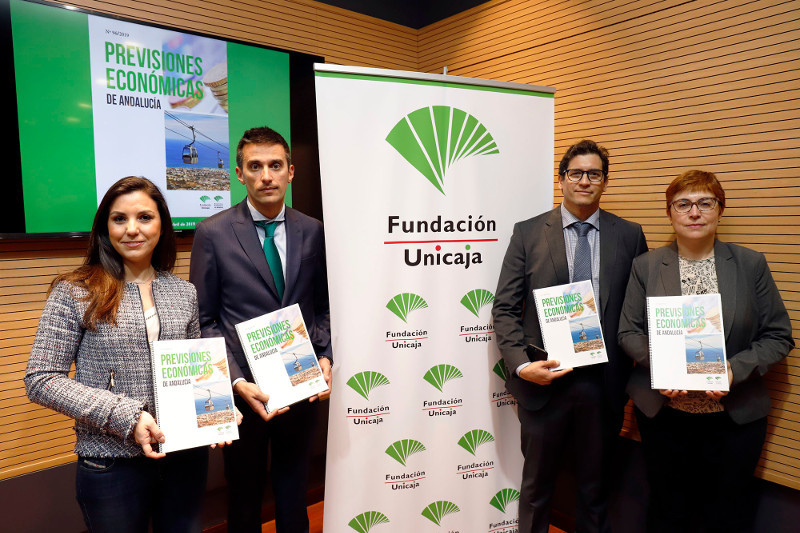The issue number 96 of the quarterly report ‘Previsiones Económicas de Andalucía’ (Economic Forecasts for Andalusia), corresponding to Spring 2019, prepared, as in previous editions, by Analistas Económicos de Andalucía (research company of Grupo Unicaja) and sponsored by Fundación Unicaja, has been presented today at the Sala Unicaja de Conciertos María Cristina, in Malaga.
The report, which analyses the recent evolution of domestic and international economies, of Andalusia and its provinces, includes outlooks on the economic growth and its components for 2019, as well as the main variables of the labour market, with growth estimations for each Andalusian province.
The report highlights the following:
Economic Environment (international and Spanish economies)
In 2018, the world economy maintains an expansionary profile, although a certain slowdown has been noticed in recent months, due mainly to the partial materialization of some episodes of uncertainty, such as the adoption of protectionist measures in international trade and the persistence of geopolitical risks.
Continuing with the trend started in the second half of 2018, the first months of 2019 have seen a loss of momentum in the global economic activity, more noticeable in the Eurozone, due to the persistence of trade tensions and certain sources of uncertainty. In this context, the main international organisms have made a downward revision of their economic forecasts for the coming years. According to the OECD, in 2019, the global economy will grow by 3.3%, 0.2 percentage points (p.p.) less than in November outlook.
Even if it has not been immune to external shocks, the Spanish economy has continued with its current expansionary phase, registering in 2018 a growth of 2.6%, 0.8 p.p. higher than that of the Eurozone. The most recent forecasts point towards a moderated growth, but with rates over 2%.
Andalusian Economy
In the fourth quarter of 2018, the Andalusian economy recorded a quarter-on-quarter growth of 0.6%, with the year-on-year rate standing at 2.2%.
As per its composition, the contribution of the internal demand has been of 2.7 p.p., underpinned by the growth in investment (4.5%) and expenditure, both of Public Administrations (2.8%) and of households (2.0%). On the other hand, the external sector would have reduced the growth in 0.5 p.p., with a higher fall in the exports of goods and services (-4.2%) than in imports (-2.8%).
From the point of view of supply, industry has been the only sector which has posted a decrease (-6.2%), with the rest of sectors growing at rates ranging from 2.7% in services to 8.5% in construction.
With regard to the labor market, the number of persons in employment is up 4.0%, with significant rises in construction (23.4%) and industry (11.2%). The sector of services has grown by 2.6%, a figure similar to that of the previous quarter. At the end of the year, unemployment stood at 21.3%, 3.2 p.p. lower than the rate of the previous year.
For 2018, Analistas Económicos de Andalucía estimate, a GDP variation of 2.4%. The contribution of the regional demand amounts to 2.8 p.p., underpinned by the growth in investment (5.1%) and public and private expenditure (2.4% and 2.1%). The contribution of the external component has been negative (-0.4 p.p.), with an increase in exports (1.5%) lower than in imports (2.3%).
From the point of view of supply, the growth in construction (8.8%) and in agriculture (4.7%) is to be highlighted, whereas services are up 2.5%.
For 2019, the outlooks expect a growth of 2.3%, in line with the whole of Spain. From the side of demand, a growth of 2.0% in households’ expenditure is expected, with slower growths in Public Administration’s expenditure (2.0%) and in investment (3.5%).
From the side of supply, a positive contribution by all sectors is expected, ranging from 1.0% in the agricultural sector to 4.0% in construction.
As for the main variables related to the labour market, a growth of 2.4% in employment is expected for the whole 2019, higher than in the previous years, with increases ranging from 7.5% in the sector of construction to 2.0% in services. The unemployment rate would reach 21.2%, 1.8 p.p. less than that registered in 2018.
Territorial Analysis (Andalusian provinces)
In the fourth quarter of 2018, according to the estimations of Analistas Económicos de Andalucía, all the Andalusian provinces have post increases in production, higher in Malaga (2.8%), Seville (2.5%) and Cadiz (2.4%).
For the whole 2018, the highest increases have been achieved in Malaga (2.8%), Cadiz (2.6%) and Seville (2.6%).
The estimations for 2019 indicate that again Malaga (2.6%), Sevilla (2.6%) and Cadiz (2.5%) will be the provinces with highest growths.



